|
|
Volume 10, Issue 7, February 2024
Farm to School in Rural Communities
|
|
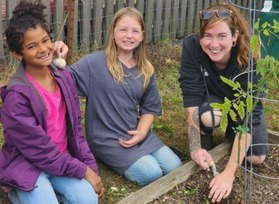
There are numerous examples of flourishing farm to school programs in urban districts with large population centers and support structures, but what do thriving farm to school programs look like in rural communities with an often very different landscape? This month, we talked with the Appalachian Sustainable Development (ASD), a Fiscal Year (FY) 2021 Patrick Leahy Farm to School grantee headquartered in Bristol, Virginia, in the Central Appalachia region, to highlight one example of a thriving program.
For more than 25 years, ASD, surrounded by an abundance of natural beauty and food insecurity, has worked with farmers and traditional and nontraditional partners to build its mission - a thriving regional food and agriculture system that creates healthy communities, respects the planet, and cultivates profitable opportunities for Appalachians. ASD sees farm to school as a critical opportunity to advance its mission.
ASD operates Learning Landscapes, a farm to school program focused on gardening to create fun experiences in nature for kids. This program has installed an impressive 74 raised garden beds at 18 schools and other youth sites throughout Virginia and Tennessee. Later this year, ASD plans to expand that number further with a garden at a newly constructed school.
|
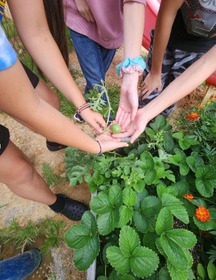
Morgan Bradley, the Regenerative Agriculture Program Manager at ASD, shared, “It’s a common misconception that rural communities, and kids who grow up in rural communities, are automatically more connected to the land and to agriculture. This is not true. Even if kids grow up on a farm, sometimes they are not exposed to the operations involved in farming and even more often, the farm is not producing fruits and vegetables for direct consumption.”
ASD wants school gardens to be an educational outlet for children to learn more about where their food comes from and enhance school nutrition programs by directly delivering school-grown foods to the cafeteria. One way Morgan has described ASD’s goal is that children can look at their lunch plates, see the produce grown in their school gardens, and think, “I made that happen.”
|

Despite ASD’s success and ambitious plans to expand its garden network, ASD faces challenges that are often unavoidable for rural farm to school programs, such as geography. ASD is actively working to overcome geographical barriers and expand farm to school in Central Appalachia’s rural communities by targeting outreach to schools and parents in the areas it serves, creating easy ways to share resources with teachers and parents, sharing accessible lesson plans for working with kids, finding consistent funding sources, and establishing great community partners and volunteers committed to the long haul.
Between FY 2022 and FY 2023, rural Patrick Leahy Farm to School grantees increased by 7%, comprising 31% of all grant award recipients for both years combined. ASD’s Learning Landscapes offer helpful insights into the successes and demands of rural farm to school programs and how USDA can support this work going forward. We are excited to see what ASD has in store for the future, and we are thrilled to be a part of their journey. If you are in the Central Appalachia region and want to learn more, reach out and volunteer!
|
|
|

Celebrate Black History Month with USDA by Advancing Nutrition Security and Health Equity
Dr. Caree Cotwright, Director of Nutrition Security and Health Equity at USDA Food and Nutrition Service, reflected in a new blog post on how she is celebrating Black History Month with a call to action to ensure everyone in this country thrives. Learn more about Dr. Cotwright’s lived experiences growing up in Georgia in this nutrition security video. Additional information about USDA’s nutrition security efforts can be found in this video, which highlights how USDA nutrition assistance programs help all Americans thrive.
|
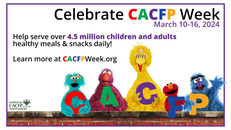
Get Ready for National CACFP Week, March 10-16
National Child and Adult Care Food Program (CACFP) Week is a national education and information campaign sponsored annually in the third week of March by the National CACFP Sponsors Association. The campaign raises awareness of how the USDA CACFP works to combat hunger. The CACFP brings healthy foods to tables across the country for children in child care centers, homes, and afterschool programs as well as adults in day care.
With CACFP Week right around the corner, here are some resources to help connect CACFP settings to local foods and agricultural education:
|
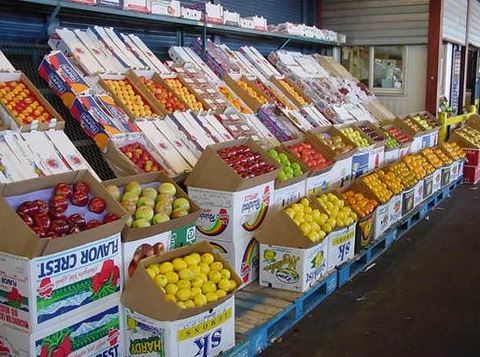
USDA Awards Grants to Support Emergency Food System and Agricultural Producers
As part of USDA’s ongoing efforts to support emergency feeding organizations and ensure families can keep healthy food on the table, the USDA Food and Nutrition Service (FNS) has awarded nearly $3.8 million in grants to 27 state agencies for Farm to Food Bank projects. “No one wants to see wasted food when we know there are American families in need,” said FNS Administrator Cindy Long. “Farm to Food Bank projects help build relationships and strengthen local communities by repurposing privately donated food - that would otherwise be wasted - for distribution through our critical emergency feeding organizations.” Click here to read about the Fiscal Year 2024 project summaries.
|
|
|


Rural Partners Network
The Rural Partners Network (RPN) is an alliance of federal agencies and civic partners working to expand rural prosperity through job creation, infrastructure development, and community improvement. The USDA Rural Development leads the RPN in collaboration with 24 federal agencies and regional commissions through the Rural Prosperity Interagency Policy, co-led by the White House Domestic Policy Council and USDA. Federal agencies are expanding interagency collaboration through RPN, and providing targeted staffing, tools, and resources. Browse here to explore funding opportunities and technical assistance to support rural community and economic development activities, or read the Rural Connection Blog to stay current on activity within the RPN and rural-based entities.
|
The Farm to School Podcast
Hear stories of how youth thrive, and farmers prosper when we grow, cook, and eat delicious, nutritious local foods in schools. Join hosts Rick Sherman, Farm to Child Nutrition Program Manager at the Oregon Department of Education, and Michelle Markesteyn, Farm to School Specialist at Oregon State University Extension, as they explore what it means to bring local food into the cafeteria, and teach kids about where their food comes from. Listen to the recent episode, Teeny School? No Kitchen? No Problem!, which highlights a School Garden Coordinator and her journey to transform a rural charter school into a farm to school oasis! If you enjoy the podcast, share it with your farm to school community for growth and inspiration!
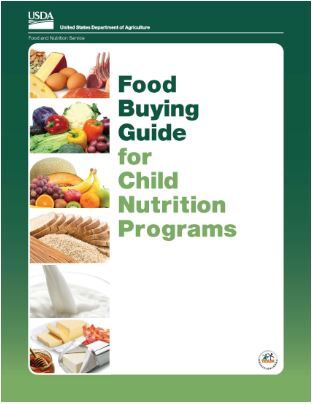
Updates to USDA Food Buying Guide for Child Nutrition Programs
The Food Buying Guide (FBG) is the essential resource for food yield information for all child nutrition programs (CNPs). The FBG assists CNP operators, food manufacturers, and other stakeholders with purchasing the correct quantity of foods and determining each food’s contributions toward meal pattern requirements. Here are some new resources and additions to the FBG web-based tool:
-
Interactive "When to Use a Preparation Yield" Flow Chart: The Preparation Yield determines the amount of food to purchase when the ingredient listed in the recipe does not match the form of the food as purchased. Find the flow chart under the "Tools" menu on the toolbar.
-
Ounce to Pounds Calculator: Users can now select the Ounces to Pounds Calculator under the "Tools" menu on the toolbar to instantly convert units.
-
New Food Yields Added: New foods are now available in the FBG! New additions include ground mutton, stew meat, and catfish fillets!
|
Growing Schools Garden Summit
The 2024 Growing School Gardens Summit in San Diego, California, from March 14-18, is quickly approaching! Join school garden professionals nationwide to connect, learn, and celebrate the power of school gardens. View the agenda here, and look forward to cooking demonstrations, workshop sessions, field trips, and amazing speakers! Make sure to mark your agenda for the USDA Patrick Leahy Farm to School presentation! The session will be co-presented with San Diego Unified School District and Fiscal Year 2020 Farm to School Grantee, Leah’s Pantry. The Summit has reached capacity but is offering a waitlist option.
|
|

2024–2025 Oregon and Washington Farm to School Institute: K-12
Through the support of an FY 2023 USDA Farm to School Grant, Ecotrust is launching a Farm to School Institute in Oregon and Washington to grow comprehensive farm to school programming in both states. The institute model is a year-long endeavor that brings site-based teams together to build relationships, network with peers, learn new skills, and create an action plan to further their farm to school goals. Learn more about the opportunity and FAQs here.
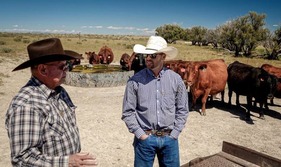
USDA Beginning Farmer and Rancher Development Program
The USDA NIFA Beginning Farmer and Rancher Development Program (BFRDP) provides grant funding to help beginning farmers and ranchers enter into or improve their successes in farming, ranching, and forest land management. BFRDP funds projects that provide education, mentoring, and technical assistance to help beginning farmers make informed decisions for their operations and enhance their sustainability.
|
USDA Value-Added Producer Grants
The USDA Rural Development (RD) Value-Added Producer Grant (VAPG) program helps agricultural producers conduct value-added activities to generate new products, create and expand marketing opportunities, and increase producer income. For example, when a farmer takes raw agricultural products and turns them into a lightly processed product, like using peaches to make peach jam, that is a value-added product. Grant and matching funds can be used for planning activities or for working capital expenses related to producing and marketing a value-added agricultural product. Find your State-specific information here.
USDA’s Strategic Economic and Community Development Initiative
USDA Rural Development is requesting applications to implement regional economic and community development projects. The Strategic Economic and Community Development (SECD) initiative supports projects and the unique strengths of rural communities to advance economic prosperity and prepare for the future through community investment planning. Rural Development can assist selected projects by identifying additional resources, convening partners, and helping leverage federal, state, local, and private funding. Find application details here.
|
|
|
USDA is an equal opportunity provider and employer. To file a complaint of discrimination, write: USDA, Office of the Assistant Secretary for Civil Rights, Office of Adjudication, 1400 Independence Ave., SW, Washington, DC 20250-9410 or call (866) 632-9992 (Toll-free Customer Service), (800) 877-8339 (Local or Federal relay), (866) 377-8642 (Relay voice users).
|
|
|
|
|